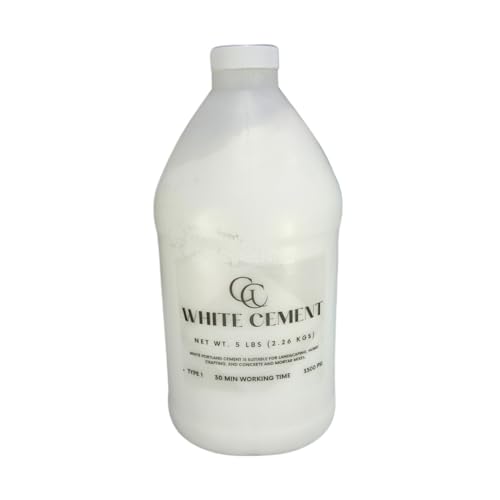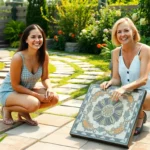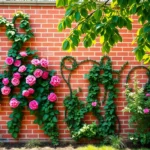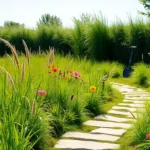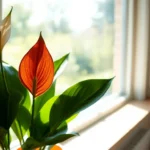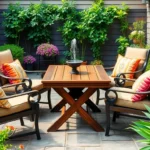We’ve all walked through stunning gardens and wondered how to transform our own outdoor spaces into something equally captivating. The secret often lies in clever cement features that add both structure and visual appeal to any industry design.
Cement isn’t just for driveways and sidewalks anymore. Today’s creative gardeners are discovering countless ways to incorporate this versatile material into their outdoor sanctuaries. From elegant planters and decorative stepping stones to artistic sculptures and functional garden borders cement offers endless possibilities for both novice and experienced DIY enthusiasts.
Whether you’re working with a sprawling backyard or a cozy patio space we’ll explore innovative cement projects that’ll elevate your garden’s aesthetic while staying budget-friendly. These ideas will help you create lasting focal points that withstand weather conditions and add tremendous value to your property.
Creative Cement Planters That Transform Your Garden Space
Cement planters offer endless possibilities for creating stunning garden displays that serve as both functional growing spaces and striking decorative elements.
Large Statement Planters for Focal Points
Oversized geometric planters create dramatic visual anchors in any garden setting. We recommend crafting rectangular or cylindrical cement planters measuring 24 to 36 inches in diameter to accommodate larger plants like ornamental grasses, small trees, or cascading flowers. These substantial containers work exceptionally well for showcasing specimen plants such as Japanese maples, dwarf conifers, or flowering shrubs.
Tiered cement planters add architectural interest while maximizing planting space in compact areas. Building multi level designs using three different sized molds creates ever-changing height variations that draw the eye upward. Popular configurations include circular tiers decreasing by 6 inches in diameter per level or square planters with 4 inch step downs.
Custom molded planters allow you to incorporate unique shapes that complement your garden’s existing design elements. Using foam insulation, cardboard boxes, or plastic containers as molds enables creation of hexagonal, triangular, or curved planters that perfectly fit corners, pathways, or exact industry features.
Small Decorative Pots for Herb Gardens
Miniature cement pots measuring 4 to 8 inches in diameter provide perfect homes for culinary herbs like basil, thyme, oregano, and parsley. Creating sets of matching small planters establishes visual cohesion while allowing individual herb varieties to thrive in properly sized containers. We suggest using yogurt containers, small buckets, or purpose built molds to achieve consistent sizing.
Textured surface pots enhance the tactile appeal of herb garden displays through simple decorating techniques. Rolling cement surfaces with burlap, pressing leaves into wet concrete, or creating rope patterns around pot exteriors adds visual interest without compromising drainage or plant health.
Labeled cement herb pots combine functionality with organization by embedding plant markers directly into the planter walls. Pressing metal letter stamps, ceramic tiles with herb names, or carved wooden signs into wet cement creates permanent identification that withstands weather and watering.
Hanging Cement Planters for Vertical Growing
Suspended bowl planters maximize growing space in small gardens while creating eye catching aerial displays. We create these using mixing bowls as molds and incorporate drainage holes plus embedded wire or chain attachment points during the cement curing process. Standard 8 to 12 inch diameter bowls work best for trailing plants like petunias, ivy, or cherry tomatoes.
Wall mounted cement pockets transform blank fence or building surfaces into productive growing areas. Creating half sphere or rectangular planters with flat backs allows secure mounting using heavy duty brackets or masonry screws. These work particularly well for shallow rooted plants such as succulents, lettuce, or strawberries.
Macrame cement hangers blend modern materials with traditional create techniques for unique vertical garden answers. Combining cement planters with rope or cord hanging systems creates bohemian style displays perfect for patios, porches, or indoor outdoor transition spaces.
Functional Cement Pathways to Guide Garden Navigation

Building on our cement planter designs, we can extend the cohesive aesthetic throughout the garden by creating functional pathways that guide visitors while maintaining visual harmony. Stamped concrete paths offer an affordable solution that adds texture and intricate patterns like cobblestone or leaf imprints to blend seamlessly with surrounding landscapes.
Stepping Stone Designs for Natural Flow
Integrated boulder stepping stones create puzzle piece connections that mimic natural stone formations throughout the garden space. We recommend designing large flat cement boulders that fit together organically, establishing a meandering path that feels authentic rather than manufactured.
Cement stepping stones with embedded planters maximize both functionality and visual appeal by incorporating small garden beds between each stone. This design approach creates natural pauses along the pathway while adding bursts of color and texture that complement our previously discussed cement planters.
Freeform stepping stone patterns allow us to embrace contemporary design principles by incorporating irregular shapes that complement natural elements like existing rocks and established plant groupings. These modern designs create visual interest while maintaining practical navigation through garden spaces.
Solid Walkway Construction for High Traffic Areas
Cobblestone inspired concrete walkways provide durability and visual appeal for areas experiencing frequent foot traffic. Stamped concrete techniques allow us to achieve the classic cobblestone appearance while maintaining the strength and longevity that cement construction offers.
Reinforced concrete pathways incorporate steel reinforcement to ensure extra strength and extended lifespan in high usage areas. We add this reinforcement during the initial pour to create walkways that withstand heavy use while maintaining their aesthetic appeal over time.
Textured surface treatments enhance both safety and visual interest by incorporating non slip patterns that complement the overall garden design. These treatments prevent accidents during wet conditions while adding another layer of design sophistication to functional pathways.
Decorative Border Integration with Existing Landscaping
Rock and stone accent borders create natural transitions between cement pathways and existing garden elements. We integrate these accents to establish visual continuity that makes cement installations feel like natural extensions of the industry rather than artificial additions.
Decorative cement edging defines pathway boundaries while adding elegant finishing touches to garden navigation systems. This edging technique creates clean lines that enhance the overall professional appearance of cement pathway installations.
Plant integrated border designs soften harsh cement edges by incorporating low growing perennials and ground covers directly adjacent to pathway borders. We position these plantings to create gradual transitions between hardscape and softscape elements, ensuring our cement pathways enhance rather than compete with existing garden features.
Artistic Cement Garden Sculptures as Outdoor Centerpieces

Cement garden sculptures transform ordinary outdoor spaces into captivating artistic environments. These durable pieces serve as permanent installations that withstand weather conditions while maintaining their visual impact throughout seasons.
Abstract Modern Designs for Contemporary Gardens
Geometric shapes define the essence of abstract cement sculptures in modern garden settings. We recommend incorporating minimalist forms that create striking focal points without overwhelming surrounding plantings. Angular designs work particularly well when positioned against curved garden beds or rounded plant groupings.
Textured surfaces enhance the visual appeal of abstract pieces by catching light at different angles throughout the day. Smooth concrete can be treated with various finishing techniques to achieve matte or glossy appearances. Colored concrete allows these sculptures to either blend harmoniously with existing garden themes or stand out as bold contrast elements.
Sculptural towers and geometric pillars create vertical interest in horizontal garden layouts. These pieces work exceptionally well in contemporary spaces where clean lines and structured design elements are priorities. Positioning multiple abstract forms at varying heights establishes visual rhythm across larger garden areas.
Traditional Figurines for Classic Garden Themes
Gods and goddesses carved from cement bring timeless elegance to established garden spaces. These classical figures connect modern gardens with historical artistic traditions while providing weather resistant alternatives to marble or stone originals. Roman and Greek inspired designs work particularly well in formal garden settings with structured plantings.
Classical animals such as lions, horses, and mythical creatures serve as protective guardians for garden entrances and pathway intersections. Wildlife themed figurines including birds, rabbits, and deer create charming focal points in cottage style gardens. These pieces often feature intricate detailing that showcases the versatility of cement as a sculptural medium.
Religious and spiritual figurines offer meaningful additions to meditation gardens and quiet reflection areas. Buddhist statues, garden angels, and other sacred figures provide contemplative focal points that enhance the peaceful atmosphere of outdoor sanctuaries.
Custom Molds for Personalized Garden Art
Unique designs created through custom molding processes allow homeowners to incorporate deeply personal elements into their garden spaces. We find that family pets immortalized in cement create touching memorials that celebrate beloved companions. These custom pieces often become conversation starters and treasured garden features.
Favorite flowers and botanical elements can be replicated through detailed mold work that captures intricate petal structures and leaf patterns. Custom plant sculptures work especially well in areas where live versions of these plants wouldn’t naturally thrive. Memorial pieces honoring family members or commemorating special occasions add profound personal significance to garden spaces.
Meaningful symbols such as family crests, religious iconography, or cultural emblems can be incorporated into larger sculptural works. These personalized touches ensure that garden art reflects the unique story and values of each homeowner while maintaining professional artistic quality.
Practical Cement Seating Solutions for Garden Relaxation

Creating comfortable seating areas transforms outdoor spaces into inviting retreats where we can unwind and connect with nature. Cement offers exceptional versatility for crafting durable garden seating that withstands weather while improving our industry’s aesthetic appeal.
Built-In Bench Construction Along Garden Borders
Integrating benches directly into garden borders creates seamless hardscape features that enhance our outdoor living spaces. These permanent seating answers become architectural elements that define garden boundaries while providing comfortable spots for relaxation and contemplation.
Concrete construction ensures exceptional durability and weather resistance for year-round enjoyment. We can incorporate steel or fiber reinforcing materials to enhance structural strength and prevent cracking over time.
Design flexibility allows us to create benches with built-in planters that combine seating with growing space. This integration maximizes functionality while maintaining visual cohesion throughout our garden design.
Surface treatments like specialized coatings and sealers protect against water damage and extend the bench’s lifespan. We can apply these protective finishes to ensure our investment remains beautiful and functional for decades.
Standalone Stool Creation for Flexible Seating
Crafting individual concrete stools provides versatile seating options that we can rearrange based on our garden’s changing needs. These portable yet sturdy pieces offer flexibility for entertaining guests or creating intimate conversation areas.
Reinforcement with steel or fiber materials enhances the structural integrity of standalone stools. We can ensure these pieces withstand regular use while maintaining their attractive appearance.
Smooth finishing techniques create comfortable seating surfaces that invite extended use. Proper surface preparation and finishing provide both aesthetic appeal and functional comfort for our garden visitors.
Placement flexibility allows us to position stools strategically throughout different garden zones. We can move these pieces seasonally to accommodate changing plant growth or create new focal points.
Curved Seating Walls for Social Garden Spaces
Designing curved seating walls creates natural gathering spaces that encourage social interaction and community building. These sculptural elements serve dual purposes as both functional seating and striking architectural features.
Concrete’s moldable nature makes it ideal for creating smooth, flowing curves that complement organic garden shapes. We can pour concrete into custom forms to achieve precise curves that enhance our industry’s natural flow.
Integration opportunities include built-in planters and lighting systems that enhance ambiance during evening gatherings. These features transform simple seating into comprehensive outdoor living environments.
Surface finishing options range from smooth textures to decorative patterns that match our garden’s overall design theme. We can customize these walls to coordinate with existing hardscape elements while creating unique focal points.
Innovative Cement Water Features That Add Tranquility

Water features bring a peaceful ambiance to any outdoor space while creating focal points that complement our existing cement garden elements. Building these features ourselves offers complete control over design and placement within our garden layout.
DIY Fountain Projects for Soothing Sounds
Cement fountains transform ordinary garden spaces into serene retreats using a simple one-to-two ratio of cement to sand mixed with water. Waterfall fountains can be constructed at home using concrete and water pumps, with designs ranging from simple single-tier structures to complex multi-level installations. Mini water pumps circulate water continuously, creating the soothing sounds that make these features so appealing.
DIY concrete rainfall fountains use standard planter pots as their foundation, requiring minimal materials while delivering maximum impact. Pipes running through the concrete core create dramatic waterfall effects that cascade down textured surfaces. These fountains work exceptionally well in both indoor conservatories and outdoor patios.
Bubbling rock features involve pouring concrete around natural stones or PVC pipes to create gentle water movement. Concrete gets molded around these central elements, forming organic shapes that blend seamlessly with surrounding landscaping. Water bubbles up through carefully positioned openings, creating subtle sounds without overwhelming nearby conversation areas.
Simple Bird Bath Construction for Wildlife
Concrete bird baths require basic cement, sand, and water ratios to form durable basins that attract local wildlife year-round. Mixing one part cement with two parts sand creates the ideal consistency for molding shallow basins with gently sloped sides. Small fountain attachments can be added to create gentle water movement that prevents stagnation.
Basin depth should measure between one and three inches to accommodate birds of various sizes safely. Textured surfaces prevent slipping while drinking or bathing, which we can achieve by pressing leaves or creating light scoring patterns before the concrete fully sets. Decorative elements like embedded stones or mosaic tiles personalize each bird bath design.
Wildlife attraction increases when we position bird baths near natural shelter sources like shrubs or garden sculptures. Adding small solar pumps creates gentle water circulation that keeps the basin fresh while producing subtle sounds that draw birds from greater distances.
Decorative Pond Edging for Water Garden Enhancement
Concrete pond edging creates clean, professional borders around existing water features using custom molds shaped to complement garden themes. Decorative shapes can include curved lines, geometric patterns, or naturalistic rock formations that blend with surrounding plantings. These edges provide stable walking surfaces while protecting pond liners from damage.
Stone and pebble integration softens harsh concrete lines by embedding natural materials directly into wet cement. River rocks, colored glass, or local stones create visual texture that connects water features to broader garden designs. This technique works particularly well when we match stone colors to existing hardscaping elements.
Natural appearance develops when we incorporate plants directly into edging designs through built-in planters or strategically placed gaps. Moss, small ferns, or trailing plants can be encouraged to grow over concrete surfaces, creating the weathered look of established water gardens. These living elements help concrete pond edges appear as natural parts of the industry rather than artificial additions.
Essential Tools and Materials for Cement Garden Projects

Success in creating stunning cement garden features starts with gathering the right tools and materials. We’ll guide you through everything needed to transform your outdoor vision into reality.
Basic Equipment Needed for Mixing and Molding
Mixing equipment forms the foundation of any cement project, with a sturdy mixing bucket, shovel, and trowel serving as your primary tools. We recommend starting with a 5-gallon bucket for smaller projects like decorative pots, while larger installations require wheelbarrows or portable mixers.
Trowels come in various sizes to handle different tasks, from 4-inch versions for detail work to 14-inch models for smoothing large surfaces. Quality trowels feature comfortable grips and durable steel blades that resist concrete buildup.
Screed boards ensure perfectly level surfaces across pathways and large installations. We’ve found that 2×4 lumber works effectively for most garden projects, though aluminum screeds offer superior straightness for professional results.
Levels prevent costly mistakes by confirming proper alignment throughout your project. A 24-inch level handles most garden applications, while torpedo levels work perfectly for smaller decorative elements.
Molds determine the final shape of your cement creations, ranging from plastic containers for simple planters to custom wooden forms for unique sculptures. Flexible rubber molds create intricate textures, while rigid forms provide clean geometric lines.
Vibrating tools eliminate air bubbles that weaken concrete structures. Palm sanders work effectively for small projects, though concrete vibrators produce superior results for larger installations.
Types of Cement Best Suited for Outdoor Use
Portland cement remains the gold standard for outdoor projects due to its exceptional strength and weather resistance. Type I Portland cement works well for most garden applications, providing 3,000-4,000 PSI strength after 28 days of curing.
Hydraulic cement sets rapidly even in wet conditions, making it perfect for water features and projects that can’t wait for ideal weather. This specialized cement achieves initial set within 3-5 minutes and reaches handling strength in 20-30 minutes.
Blended cement combines Portland cement with supplementary materials like fly ash or slag, offering improved workability and enhanced resistance to freeze-thaw cycles. These blends cost 10-15% more than standard Portland cement but provide superior long-term durability.
High-early-strength cement accelerates project timelines by reaching 70% of final strength within 24 hours. We recommend this option for time-sensitive installations or projects requiring quick form removal.
Safety Gear and Protective Measures for DIY Projects
Gloves protect hands from cement’s alkaline properties, which cause severe skin irritation and chemical burns. Nitrile gloves offer excellent dexterity, while rubber gloves provide superior chemical resistance for extended mixing sessions.
Dust masks prevent inhalation of cement particles that cause respiratory irritation and long-term health issues. N95 respirators filter 95% of airborne particles, while P100 masks provide maximum protection during dry mixing operations.
Safety glasses shield eyes from concrete splatter and flying debris during mixing and finishing work. Wraparound styles offer superior coverage, while anti-fog coatings maintain clear vision in humid conditions.
Work area protection preserves surrounding surfaces and simplifies cleanup after project completion. Plastic sheeting protects plants and walkways, while cardboard absorbs minor spills without permanent staining.
Proper ventilation becomes crucial when working with cement in enclosed spaces or during hot weather. We always work in open areas and take frequent breaks to prevent overexposure to cement dust and fumes.
Step-by-Step Techniques for Successful Cement Garden Crafting

Mastering cement garden projects requires understanding the fundamentals of mixing, molding, and finishing. We’ll guide you through proven techniques that ensure your outdoor cement features withstand weather conditions while maintaining their aesthetic appeal.
Proper Mixing Ratios for Different Project Types
General garden projects benefit from the reliable 1:2:3 ratio of cement, sand, and aggregate. This combination works perfectly for garden paths, small ornaments, and decorative stepping stones that experience moderate foot traffic.
Stronger structural elements require the 1:2:4 mixing ratio for enhanced durability. We recommend this formula when creating planters, large garden features, or any cement element that needs to support important weight over time.
Heavy duty applications demand the high strength 1:1.5:3 ratio for maximum structural integrity. This mixture excels in columns, substantial planters, and load bearing garden features that face constant stress.
| Project Type | Cement | Sand | Aggregate | Best Use Cases |
|---|---|---|---|---|
| General Use | 1 | 2 | 3 | Paths, small ornaments |
| Stronger Structures | 1 | 2 | 4 | Planters, large features |
| High Strength | 1 | 1.5 | 3 | Columns, heavy duty planters |
Molding and Shaping Methods for Beginners
Plastic and silicone molds offer the easiest entry point for creating intricate cement designs. These commercial molds produce consistent results for garden ornaments, planters, and decorative elements without requiring advanced sculpting skills.
Free form shaping allows unlimited creative expression using basic tools like trowels and sculpting implements. We find this method particularly rewarding for unique garden sculptures and custom architectural elements that reflect personal style.
Release agents prevent cement from sticking to molds and ensure clean removal once curing completes. Apply these products generously to mold surfaces before pouring cement to avoid cracking or surface damage during demolding.
Template guides help maintain consistent dimensions and proportions across multiple pieces. Create cardboard or wooden templates for repetitive elements like stepping stones or border sections to achieve professional uniformity.
Curing and Finishing Processes for Durability
Initial moisture retention during the first several days determines final strength and longevity. Keep cement surfaces consistently damp using plastic sheeting, wet burlap, or regular misting to prevent premature drying and cracking.
Sealant application protects finished cement from weathering and extends lifespan significantly. We apply high quality concrete sealers after full curing to create a barrier against moisture penetration and freeze thaw cycles.
Color integration during the mixing phase produces more vibrant and lasting results than surface painting. Add cement pigments or dyes directly to the wet mixture for uniform color distribution throughout the entire piece.
Surface finishing techniques like brushing, stamping, or texturing should occur while cement remains workable. These treatments enhance both visual appeal and slip resistance for functional garden elements like pathways and seating areas.
Maintenance Tips to Keep Your Cement Garden Features Looking Fresh

Once you’ve created beautiful cement features for your garden, proper maintenance ensures they’ll continue improving your outdoor space for years to come. Regular care prevents costly repairs and keeps your concrete elements looking their absolute best.
Cleaning Methods for Different Weather Conditions
Summer maintenance requires frequent cleaning with a hose and stiff brush to remove dust and debris from cement surfaces. We recommend avoiding high-pressure washers during hot months as they can damage the concrete surface. Regular sweeping or blowing removes leaves and organic matter that might stain your features.
Winter cleaning focuses on promptly clearing snow and ice to prevent freeze-thaw cycles that damage concrete structures. Salt and chemical deicers should be avoided as they can deteriorate cement over time. Instead, use sand for traction without causing chemical damage to your garden features.
Spring and fall cleaning involves thorough washing with soap and water or a gentle power washer to remove accumulated dirt and stains. These transitional seasons provide ideal conditions for deep cleaning before and after harsh weather periods. Stubborn stains respond well to specialized concrete cleaners applied with a stiff brush.
Sealing Techniques to Prevent Cracking and Damage
Proper sealer selection depends on your exact cement project requirements. Commercial or industrial garden features benefit from professional grade sealers like W.R. Meadows products, while decorative elements perform well with ICS High Gloss Sealer for enhanced appearance.
Application timing requires clean, completely dry surfaces before sealer application. We suggest waiting at least 24 hours after cleaning before applying any protective coating. Multiple thin coats provide better protection than single thick applications.
Coverage patterns should overlap slightly to ensure complete protection against moisture, dirt, and stains. Fresh sealer applications typically require 24 to 48 hours of dry weather for proper curing. Resealing every 2 to 3 years maintains optimal protection levels.
Seasonal Care Requirements for Long-Term Success
Spring inspections should include thorough crack examination and immediate filling of any gaps to prevent expansion during freeze-thaw cycles. This season provides perfect conditions for resealing work after winter damage assessment. Complete cleaning prepares surfaces for any necessary repairs.
Summer monitoring involves regular visual checks for new stains or surface damage from increased garden activity. Heat can accelerate wear on unsealed surfaces, making protection especially important during peak temperature months. Consistent cleaning prevents permanent staining from organic materials.
Fall preparation includes comprehensive crack sealing before winter weather arrives. All loose debris should be cleared from cement surfaces to prevent staining during wet months. Final sealing applications create protective barriers against upcoming harsh conditions.
Winter protection requires prompt snow and ice removal using plastic shovels rather than metal tools that might scratch surfaces. Covering vulnerable decorative elements with breathable materials prevents moisture accumulation while allowing air circulation. Regular monitoring ensures early detection of any weather related damage.
Conclusion
We’ve explored countless ways to transform your outdoor space using cement’s incredible versatility and affordability. From elegant planters and sculptural focal points to functional seating and tranquil water features these DIY projects offer endless possibilities for creative expression.
The beauty of working with cement lies in its adaptability to any garden size or style. Whether you’re creating a modern geometric planter or a traditional figurine these projects can be customized to reflect your personal taste while adding lasting value to your property.
With the right tools materials and maintenance approach your cement garden features will provide years of enjoyment. Start with a simple project like decorative stepping stones or small planters then expand your skills as you gain confidence working with this remarkably versatile material.
Frequently Asked Questions
What are the best cement features for small outdoor spaces?
For small outdoor spaces, consider tiered planters that maximize vertical growing space, cement stepping stones with embedded planters, and wall-mounted cement pockets. These features provide functionality without overwhelming compact areas. Decorative cement edging also helps define spaces while maintaining clean lines and visual cohesion.
How do I create durable cement planters for my garden?
Use a proper concrete mix ratio (1:2:3 for general use), ensure adequate drainage holes, and apply sealant after curing. Choose appropriate molds or create custom shapes, allow proper curing time with moisture retention, and consider reinforcement for larger planters to prevent cracking and ensure longevity.
What’s the ideal concrete mix ratio for garden projects?
For general garden features, use a 1:2:3 ratio (cement:sand:gravel). For stronger structures like seating or heavy planters, use 1:2:4. For heavy-duty applications requiring maximum durability, opt for 1:1.5:3. Always ensure proper water content and thorough mixing for best results.
How can I make cement garden features look more natural?
Incorporate textured surfaces, use colored concrete during mixing, add rock and stone accents, and integrate plant-friendly border designs. Consider embedding natural materials, using organic shapes rather than geometric ones, and allowing plants to grow around edges to soften harsh cement lines.
What maintenance do cement garden features require?
Regular cleaning based on weather conditions, seasonal inspections for cracks, and annual sealant application are essential. Remove debris promptly, check for structural integrity, and address minor repairs immediately to prevent costly damage. Proper maintenance ensures features remain attractive and functional for years.
Can I create water features using cement?
Yes, cement is excellent for water features. You can build DIY fountains, bubbling rock features, concrete bird baths, and decorative pond edging. Ensure proper waterproofing with appropriate sealants, create adequate drainage systems, and consider pump placement for fountains to achieve desired water flow effects.
What tools do I need for cement garden projects?
Essential tools include mixing buckets, trowels, screed boards, various molds (plastic or silicone), release agents, and finishing tools. For larger projects, consider a wheelbarrow for mixing, levels for accuracy, and protective equipment. Quality tools ensure professional results and make the construction process more efficient.
How long does cement take to cure for garden features?
Initial setting occurs within 24-48 hours, but full curing takes 28 days for maximum strength. Keep cement moist during the first week using plastic coverings or periodic water misting. Avoid heavy use during the first week, and wait at least 7 days before removing molds or applying significant stress.









